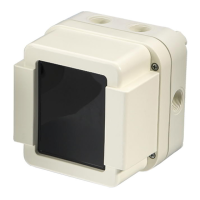3.3 Electrical connection
● Specialist electrical engineering knowledge is required for installation.
● Only an expert is permitted to carry out installation work.
Incorrect installation can take safety devices out of operation unbeknown to a
layperson.
The electrical connection depends on the following factors:
● Connection to an FDnet/C-NET detector line or collective detector line
● Use of unshielded cables or shielded cables
The general process is described below. The connection diagrams and more
information on the various connection variants can be found in the following
chapters.
Note the following with regard to the electrical connection:
CAUTION
Using the device in a damp and/or corrosive environment
Device function is impaired.
● Use the M20x1.5 metal cable gland in damp and/or corrosive environments.
Note the positive and negative poles.
Only connect one wire per terminal. This is the only way to ensure the connection
is failure-free for the entire service life of the device.
● Wherever possible use twisted, unshielded cables. Shielded cables are only
required in special cases, such as strong high-frequency fields. This also
applies to connecting the external alarm indicators.
● Only use cables with a conductor cross-section of 0.2…1.5mm
2
.
General procedure
w The detector base and the carrier for connection terminals are mounted.
1.
Connect the wires as shown in the corresponding connection diagram. Use a
screwdriver to remove the load from the springs in the socket strip so you can
slide in the wire.
2.
If you are using the detector heating unit, connect the wires of the 24 V supply
according to the connection diagram shown below.
Figure 11: Connection diagram for the detector heating unit
3.3.1 Connection to an addressed detector line
The following applies to FDnet/C-NET detector lines:
Mounting/Installation
Electrical connection
3
14 | 44 A6V10332811_e_en_--

